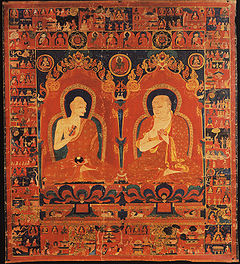- Buton Rinchen Drub
-
Buton Rinchen Drub 
A 14th century wall painting depiction of abbot Buton Rinchen (left) and his successorTibetan name Tibetan: བུ་སྟོན་རིན་ཆེན་གྲུབ་ Wylie transliteration: bu ston rin chen grub pronunciation in IPA: pʰutø̃ rĩtɕʰẽtʂup official transcription (PRC): Pudoin Rinqênzhub THDL: Buton Rinchendrup other transcriptions: Buton Rinchen,
Butön Rinchendrup,
Budon Rinchendub,
Purdain RinqenzhubChinese name traditional: 布敦仁欽竹 simplified: 布敦仁钦竹 Pinyin: Bùdūn Rénqīngzhú Buton Rinchen Drub (Tibetan: བུ་སྟོན་རིན་ཆེན་གྲུབ་, Wylie: Bu-ston Rin-chen Grub), (1290-1364), 11th Abbot of Shalu Monastery, was a fourteenth century Sakya master and Tibetan Buddhist leader (Kinship Relations: rgyal mtshan dpal bzang Father - bsod nams 'bum Mother). Shalu was the first of the major monasteries to be built by noble families of the Tsang Dynasty during Tibet's great revival of Buddhism, and was an important center of the Sakya tradition. Buton was not merely a capable administrator but he is remembered to this very day as a prodigious scholar and writer and is Tibet's most celebrated historian. Buton catalogued all of the Buddhist scriptures at Shalu, some 4,569 religious and philosophical works and formatted them in a logical, coherent order. He wrote the famous book, the History of Buddhism in India and Tibet at Shalu which many Tibetan scholars utilize in their study today.
After his death he strongly influenced the development of esoteric studies and psychic training in Tibet for centuries. The purpose of his works were not to cultivate paranormal magical abilities but to attain philosophical enlightenment, a belief that all earthly phenonoma are a state of the mind. He remains to this day one of the most important Tibetan historians and Buddhist writers in the history of Buddhism and Tibet
Panchen Sönam Drakpa (1478-1554), the fifteenth abbot of Ganden monastery, became known as an incarnation of the great lama and historian, Bütön Rinchen Drupa.[1]
Contents
Further reading
- Chandra, Lokesh ed. The Collected Works of Bu-ston 26v. (Śatapiṭaka Series 64) New Delhi: International Academy of Indian Culture, 1971.
- Rinchen Namgyal, Dratshdpa (Author), Van Der Bogaert, Hans (Translator) A Handful of Flowers: A Brief Biography of Buton Rinchen Drub. Dharamsala: Library of Tibetan Works and Archives, 1996. ISBN 8186470042
- Ruegg, David Seyfort. The life of Bu ston Rin po che: With the Tibetan text of the Bu ston rNam thar, Serie orientale Roma XXXIV. Roma: Instituto italiano per il Medio ed Estremo Oriente, 1966.
- Schaeffer, Kurtis R. “A letter to the editors of the Buddhist canon in fourteenth-century Tibet: the yig mkhan rnams la gdams pa of Bu ston Rin chen grub.” in The Journal of the American Oriental Society 01-APR-2004
See also
- Zhentong
- Drakpa Gyaltsen (1147-1216)
- Tulku Dragpa Gyaltsen (1619-1656)
Sources
- ^ Tales of Intrigue from Tibet's Holy City: The Historical Underpinnings of a Modern Buddhist Crisis Thesis by Lindsay G. McCune, p. 51 The Florida State University College of Arts and Sciences
External links
- rgyal mtshan dpal bzang ( b. 13th cent. )
- TBRC P155 Bu ston Rin chen grub
- TBRC Outline of the Collected Works of Bu ston Rin chen grub
- Buddhism Dictionary: Butön rin-chen-grup
- Butön Rinchen Drup
Part of a series on
Buddhism
Dharma or concepts
Four Noble Truths
Five Aggregates
Impermanence
Suffering · Non-self
Dependent Origination
Middle Way · Emptiness
Karma · Rebirth
Samsara · CosmologyPractices
Three Jewels
Noble Eightfold Path
Morality · Perfections
Meditation · Mindfulness
Wisdom · Compassion
Aids to Enlightenment
Monasticism · LaityNirvāṇa
Four Stages · Arahant
Buddha · BodhisattvaTraditions · Canons
Theravāda · Pali
Mahāyāna · Chinese
Vajrayāna · TibetanBuddhism
Wikimedia Foundation. 2010.

